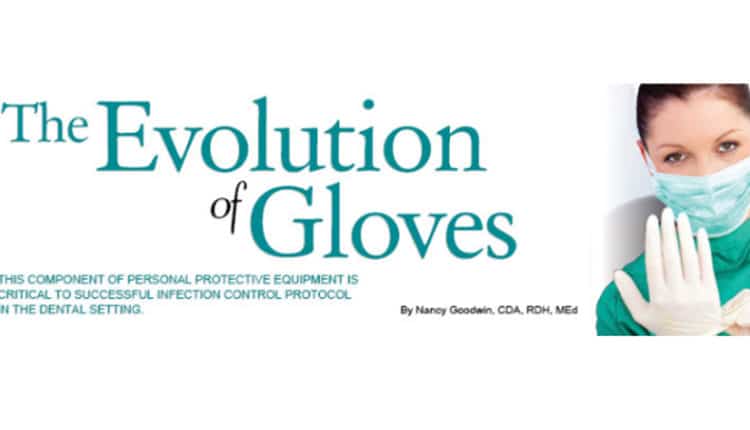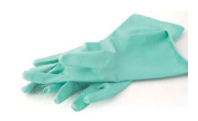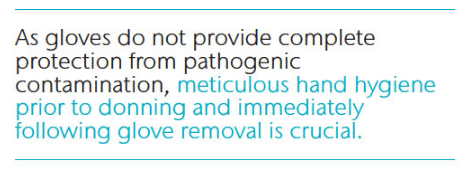
The Evolution of Gloves
This component of personal protective equipment is critical to successful infection control protocol in the dental setting.
The World Health Organization (WHO), United States Centers for Disease Control and Prevention (CDC), Organization for Safety and Asepsis Procedures, and Occupational Safety and Health Administration all consider proper hand hygiene with the appropriate use of gloves critical to protecting the health of clinicians and patients in every sector of health care. Although gloves have been used in dentistry for the past 40 years, a review of the protocols regarding this important piece of personal protective equipment is a continuing need. There is an abundance of material to guide clinicians in proper glove use. Numerous studies, however, have documented problems with compliance.1,2
In addition to protocols for glove use, researchers have continued to expand recommendations in many areas, such as types of gloves, ergonomics, use of lotions, jewelry wearing, and artificial nail use. Manufacturers have also improved glove quality and choices of materials.
GLOVE USE
 The emergence of the human immunodeficiency virus (HIV) in the early 1980s was the catalyst that forced the health care field, including dentistry, to make changes to infection control protocols, including glove use.3 Prior to this, gloves were commonly used for surgery and with patients who had documented cases of hepatitis, but not for routine care. The availability of nonsterile exam gloves was also very limited. Research also revealed that other bloodborne pathogens, particularly hepatitis B (HBV), were much more virulent and, therefore, more easily transmittable than HIV, increasing the risk of infection for dental health care workers. HBV is still considered the most significant threat to unvaccinated dental clinicians,4,5 while hepatitis C, for which there is no vaccine, is continuing to emerge along with methicillin-resistant Staphylococcus aureus (MRSA) and multi-drug resistant tuberculosis.
The emergence of the human immunodeficiency virus (HIV) in the early 1980s was the catalyst that forced the health care field, including dentistry, to make changes to infection control protocols, including glove use.3 Prior to this, gloves were commonly used for surgery and with patients who had documented cases of hepatitis, but not for routine care. The availability of nonsterile exam gloves was also very limited. Research also revealed that other bloodborne pathogens, particularly hepatitis B (HBV), were much more virulent and, therefore, more easily transmittable than HIV, increasing the risk of infection for dental health care workers. HBV is still considered the most significant threat to unvaccinated dental clinicians,4,5 while hepatitis C, for which there is no vaccine, is continuing to emerge along with methicillin-resistant Staphylococcus aureus (MRSA) and multi-drug resistant tuberculosis.
In 2003, the CDC published Guidelines for Infection Control in Dental Healthcare Settings, in which detailed protocols and recommendations for glove use were specified. These recommendations are still considered the gold standard.
ERGONOMICS AND GLOVE USE
Due to the repetitive nature of clinical practice, dental hygienists are at risk for cumulative trauma disorders, including carpal tunnel syndrome. In addition to other factors that contribute to musculoskeletal health, clinicians should choose not only the right glove material, but also the proper type and size for their individual needs.
are at risk for cumulative trauma disorders, including carpal tunnel syndrome. In addition to other factors that contribute to musculoskeletal health, clinicians should choose not only the right glove material, but also the proper type and size for their individual needs.
Basic instruction in instrumentation dedicates much attention to maintaining a neutral position to prevent injury;6 however, ambidextrous gloves can place the thumb in a non-neutral position. The use of gloves that can be worn on either hand with few choices in size may lead to hand injury. These types of gloves are not made on hand-shaped formers during the manufacturing process, but rather on flat formers, which inhibits the movement of the glove and its ability to conform to the user’s hands. This can lead to pain and fatigue and restricted blood flow.7 Ambidextrous gloves are satisfactory for short appointments, but for typical dental hygiene care appointments, sized right- and left-hand gloves are preferable.
In addition to type, size is another critical factor in glove choice. When correctly sized gloves are worn, manual dexterity is improved.8 If gloves are too large, excess material is left at the fingertips. If they are too small, discomfort and restriction ensue.9 When gloves fit correctly, there is a reduction in fatigue and tension of the hand, palm, and wrist, and blood flow is unobstructed. Additionally, textured gloves can reduce instrument slipping.10 As such, the ideal ergonomic glove is sized, right- and left-handed, and textured.
GLOVE TYPES
Only gloves specifically designed for treatment room disinfection and instrument processing should be used for these activities. Disinfection or utility gloves may be made of nitrile, latex, or other materials, but they must be constructed from heavy duty material that is puncture resistant. This type of glove is made to protect clinicians from parenteral injury while processing instruments and enables the safe handling of intermediate-level disinfectants used in treatment room processing. Gloves that are designed for patient care—whether nitrile, latex, or vinyl—do not meet these requirements. Not only is a clinician at risk for an exposure incident/injury while carrying out these tasks in routine exam gloves, but disinfectants can compromise these materials, allowing the disinfectant to be wicked through micropunctures in the gloves onto hands.5
Utility gloves may be decontaminated for reuse if the integrity of the glove is not compromised. Wash with antimicrobial soap, remove carefully, spray with disinfectant, and allow to dry. They must be discarded if they are cracked, peeling, torn, punctured, or exhibit other signs of deterioration or when their ability to function as a barrier is compromised.
Latex gloves are comfortable and are commonly used for exams and routine general dental procedures. These nonsterile examination gloves come in both ambidextrous and sized right- and left-hand styles and can be found in various flavors, textures, and colors and in powdered or nonpowdered options. Sterile latex gloves are available in both surgical and reduced-protein surgeon’s gloves. Latex gloves typically provide better fine-finger dexterity than nitrile gloves.9,11
The downside of using latex gloves is the increased risk of sensitivity/allergy among both clinicians and patients. The cornstarch used in powdered-glove styles may increase this risk because it serves as a carrier for latex proteins and processing chemicals to the skin of the hands.5 These particles enter the air when gloves are changed and can be inhaled. To reduce these risks, many offices have opted to become latex-free. Another concern is that latex gloves may puncture more easily than the nitrile options.9,12
Nitrile gloves offer excellent tear-resistance and are also available in different colors and textured and nontextured designs. They provide a higher puncture resistance13 and a lower failure rate compared to other glove types.14 Nitrile gloves have a higher stiffness value, so it may take time for clinicians to adjust to the different feeling of these gloves.
Neoprene gloves are comfortable and provide good barrier protection, but they may be more expensive. They are available in nonsterile examination style or sterile surgical gloves. They are most effective in stopping the permeability of dental materials containing different types of methacrylate.14
Vinyl or plastic gloves are very inexpensive but have a higher failure rate.14 They are available in a nonsterile examination option only. Heat-resistant gloves should be utilized when there is a risk of burning hands or forearms while handling instruments after sterilization. Thin plastic “food handler” gloves (overgloves) can be worn over contaminated patient care gloves when touching or retrieving items that will not be sterilized or are not barrier protected during patient treatment. Care must be taken during placement and removal; it is important not to contaminate the outside surface of overgloves or they will not fulfill their purpose. They are not approved or recommended for use during patient care or disinfection procedures.
PROTOCOLS FOR GLOVE USE
Gloves should be worn when clinicians may come into contact with blood or other potentially infectious materials (OPIM), mucous membranes, or nonintact skin and when handling or touching contaminated items or surfaces.5,15
 Hands that are visibly soiled should be washed immediately before glove placement and patient care, as well as immediately upon glove removal. If hands are not visibly soiled, the use of an alcohol-based handrub is acceptable. The wearing of gloves does not replace the need for hand washing. Research demonstrates, however, that there is a persistent misconception that glove use is an acceptable substitute for hand hygiene.2 Studies continue to show that health care workers often fail to perform proper hand hygiene prior to placement or after glove removal.16,17 Clinicians can pick up pathogenic microorganisms from surfaces before gloves are donned. These bacteria then rapidly multiply on the skin underneath the gloves.18 This failure in the hand hygiene protocol is associated with health care-associated infections and the spread of multi-resistant organisms, including MRSA.
Hands that are visibly soiled should be washed immediately before glove placement and patient care, as well as immediately upon glove removal. If hands are not visibly soiled, the use of an alcohol-based handrub is acceptable. The wearing of gloves does not replace the need for hand washing. Research demonstrates, however, that there is a persistent misconception that glove use is an acceptable substitute for hand hygiene.2 Studies continue to show that health care workers often fail to perform proper hand hygiene prior to placement or after glove removal.16,17 Clinicians can pick up pathogenic microorganisms from surfaces before gloves are donned. These bacteria then rapidly multiply on the skin underneath the gloves.18 This failure in the hand hygiene protocol is associated with health care-associated infections and the spread of multi-resistant organisms, including MRSA.
Contamination can occur through undetected breaks in the glove’s integrity and during glove removal. Morgan et al19 found that among interactions between gloved health care workers and patients with drug-resistant Acinetobacter baumannii, 36.2% of the health care workers’ gloves were contaminated with the bacterium and 4.5% of the health care workers’ hands were contaminated after the gloves were removed. McBryde et al20 reported that among gloved health care workers exposed to MRSA, 13% of health care workers’ hands were contaminated with the virulent bacterium after their gloves were removed.
According to the CDC, one of the most common factors in noncompliance with hand hygiene protocols is the false sense of security provided by gloves.21 As gloves do not provide complete protection from pathogenic contamination,5 meticulous hand hygiene prior to donning and immediately following glove removal is crucial. The WHO has published an excellent review of hand washing protocols that is available at: who.int/gpsc/5may/How_To_HandWash_Poster.pdf.
OTHER RECOMMENDATIONS
How long gloves are worn also affects efficacy. The probability of microtears and holes increases with the amount of time worn.22 Gloves should be changed after every hour of patient care and replaced immediately if they become torn or compromised during treatment. As previously discussed, hands should be washed or an alcohol-based handrub should be used before redonning.
Patient care gloves should not be washed with any type of detergent or chemical because this weakens the stabilizers in the glove, causing microtears. Gloves that have been washed no longer provide an effective barrier. If a clinician desires to reduce the amount of glove powder present, rinsing with water is an acceptable practice. Gloves are manufactured for single-use and regulated by the United States Food and Drug Administration, and should never be reused.
Nails should be kept short—no longer than 1?4 inch.23,24 Artificial fingernails, including any nail enhancement or resin-bonding product, should not be worn with gloves. Rings should not be worn while performing hand hygiene or under gloves. The risk of contamination increases synchronously with the number of rings worn.20,25
Hand lotions that contain petroleum should be avoided because they can weaken latex gloves and increase permeability.16 Only water-based lotions should be used during the work day. If the clinician is providing lubricant for the patient’s lips during the appointment, a nonpetroleum product, such as cocoa butter, should be chosen for the same reason. Additionally, as intact skin is a barrier to disease transmission, clinicians should make every effort to maintain healthy skin on their hands.
CONCLUSION
The importance of glove use for dental professionals cannot be overemphasized. Clinicians should choose the glove that is specifically recommended for the task, and should pay special attention to the sizing and type for their individual needs. Recommendations and cautions regarding lotions, jewelry, and artificial nails should be heeded. Gloves should be worn without fail when there is any risk of contacting blood or OPIM. Hands should be washed or an alcohol-based handrub used immediately before donning gloves for patient care and immediately after removal, or if gloves become compromised and must be removed and redonned during treatment. Glove use should never be viewed as a substitute for consistent and meticulous hand hygiene.
REFERENCES
- Wearing gloves: the worst enemy of hand hygiene? Future Microbiology. 2011;6:835. 2
- Girou E, Chai S, Brun-Buisson C, et al. Misuse of gloves: the foundation for poor compliance with hand hygiene and potential for microbial transmission? J Hosp Infect. 2004;57:162–169.
- Molinari M. Infection control: its evolution to the current standard precautions. J Am Dent Assoc. 2003;134:569.
- Miller, CH, Palenik, CJ. Infection Control and Management of Hazardous Material for the Dental Team. 4th ed. St Louis: Elsevier; 2010:107–111.
- Kohn WG, Collins AS, Cleveland JL, et al. Guidelines for infection control in dental health-care setting—2003. MMWR Recomm Rep. 2003;19;52:1–61.
- Nield-Gehrig JS. Fundamentals of Periodontal Instrumentation and Advanced Root Instrumentation. 7th ed. Philadelphia: Lippincott Williams & Wilkins; 2012:80.
- Parker ME. Preserve your arm and hand health. Dimensions of Dental Hygiene. 2003;1(6):32–38.
- Drabek T, Boucek C, Buffington C. Wearing the wrong size latex surgical gloves impairs manual dexterity. J Occup Environ Hyg. 2010;7:152–155.
- Sawyer J. Comparing the level of dexterity offered by latex and nitrile safeskin gloves. Ann Occup Hyg. 2006;50:289–296.
- Darby M, Walsh M. Dental Hygiene Theory and Practice. 2nd ed. St Louis: Elsevier Science; 2003:123–133.
- Berger M, Krul A, Daanen H. Task specificity of finger dexterity tests. Appl Ergon. 2009;401:145–147.
- Korniewicz DM, El-Masri M, Broyles JM, Martin CD, O’Connell KP. Performance of latex and nonlatex medical examination gloves during simulated use. Am J Infect Control. 2002;30:133–138.
- Patel HB, Fleming GJ, Burke FJ. Puncture resistance and stiffness of nitrile and latex dental examination gloves. Br Dent J. 200412;196:695–700.
- Andreasson H, Boman A, Johnsson S, Karlsson S, Barregård L. On permeability of methyl methacrylate, 2-hydroxyethyl methacrylate and triethyleneglycol dimethacrylate through protective gloves in dentistry. Eur J Oral Sci. 2003;111:529–535.
- Occupational Health and Safety Administration. Regulations 1910.132(a). Available at: osha.gov/pls/oshaweb/owadisp.show_document?p_table= STANDARDS&p_id=9777. Accessed August 19, 2014.
- Loveday H, Lynam S, Singleton J, Wilson J. Clinical glove use: healthcare workers’ actions and perceptions. J Hosp Infect. 2014;86:110–116.
- Eveillard M. Wearing gloves: the worst enemy of hand hygiene? Future Microbiol. 2011;6:835.
- Messano G. Bacterial and fungal contamination of dental hygienists’ hands with and without finger rings. Acta Stomatologica Naissi. 2013;29:1260.
- Morgan DJ, Liang SY, Smith CL, et al. Frequent multidrug resistant Acinetobacter baumannii contamination of gloves, gowns, and hands of healthcare workers. Infect Control Hosp Epidemiol. 2010;32:716–721.
- McByrde ES, Bradley LC, Whitby M, McElwain DLS. An investigation of contact transmission of methicillin-resistant Staphylococcus aureus. J Hosp Infect. 2004;58:104–108.
- Centers for Disease Control and Prevention. Guideline for Hand Hygiene in Health-Care Settings: Recommendations of the Healthcare Infection Control Practices Advisory Committee and the HICPAC/ SHEA/APIC/IDSA Hand Hygiene Task Force. MMWR Morb Mortal Wkly Rep. 2002;51(RR-16):6–32.
- Pitten F, Herdemann G, Kramer A. The integrity of latex gloves in clinical dental practice. Infection. 2000;28:388.
- Toles A. Artificial nails: are they putting patients at risk? A review of the research. J Pediatr Oncol Nurs. 2002;19:164–171.
- Porteous J. Artificial nails… very real risks. Can Oper Room Nurs J. 2002;20:16–17, 20–21.
- Trick W, Vernon M, Weinstein R, et al. Impact of ring wearing on hand contamination and comparison of hand hygiene agents in a hospital. Clin Infect Dis. 2003;36:1383–1390.
From Dimensions of Dental Hygiene. September 2014;12(9):30,32,34,36.

